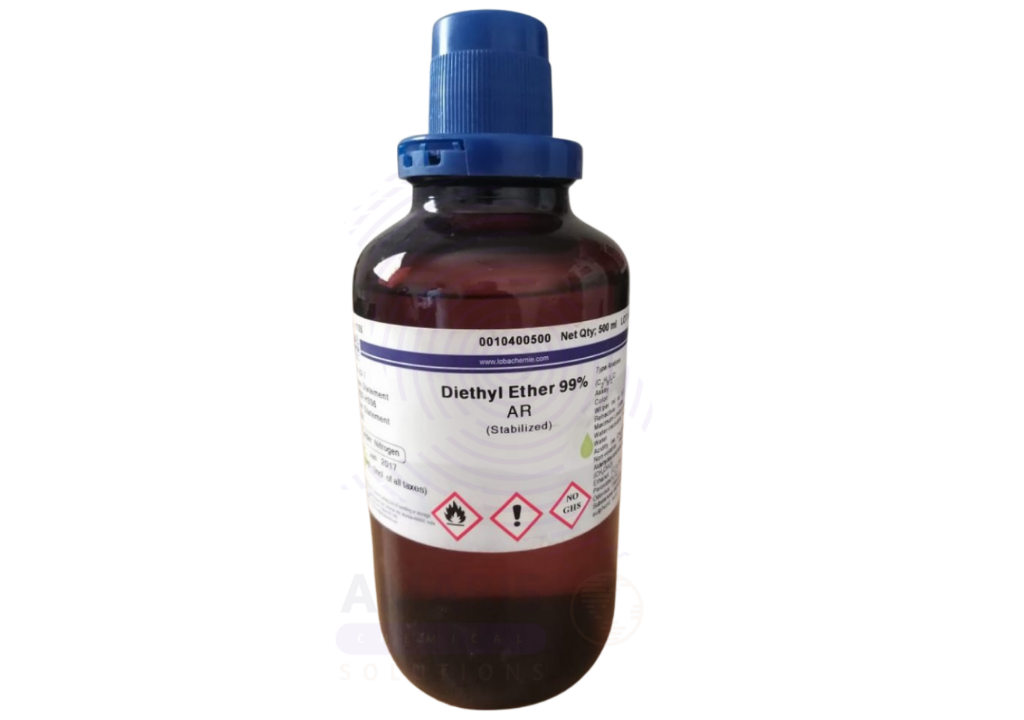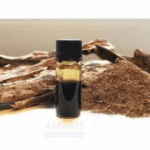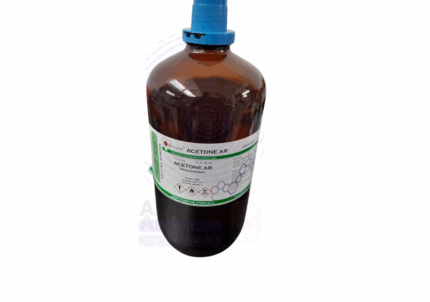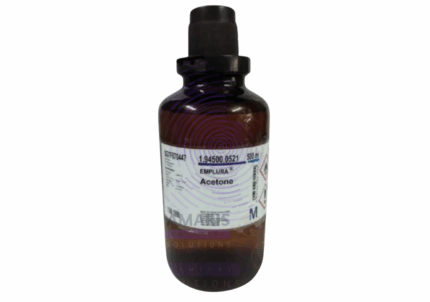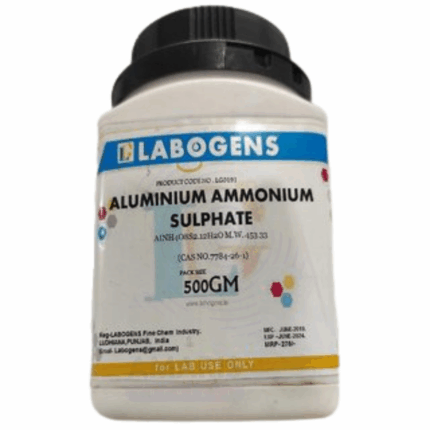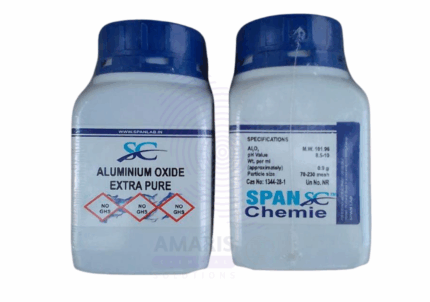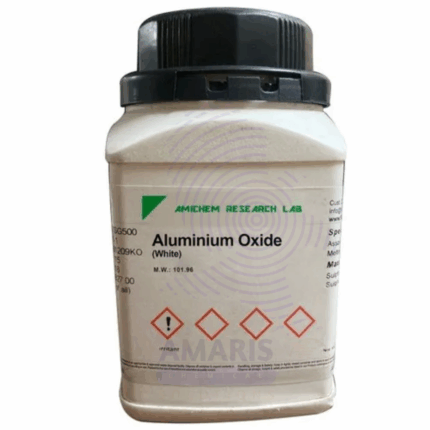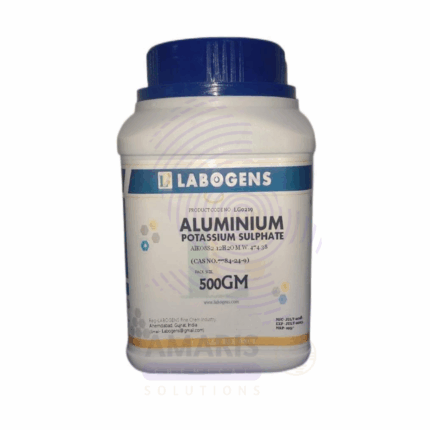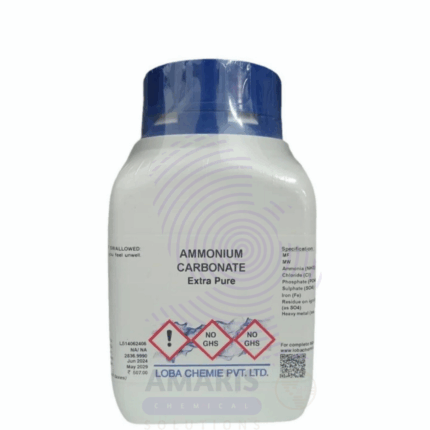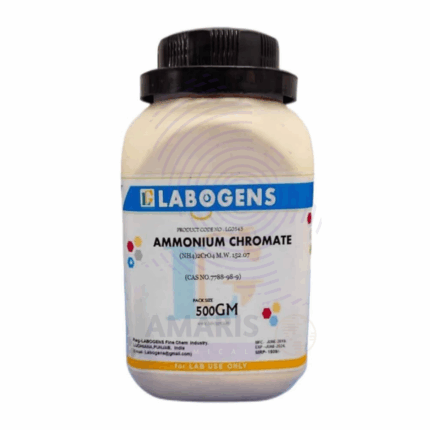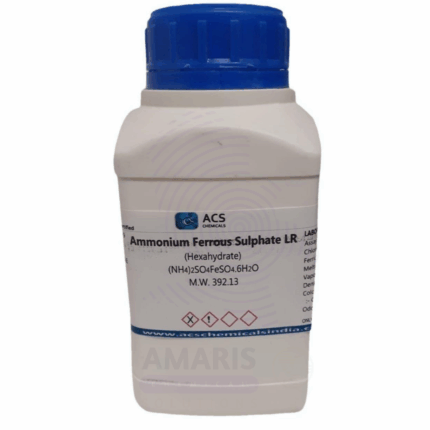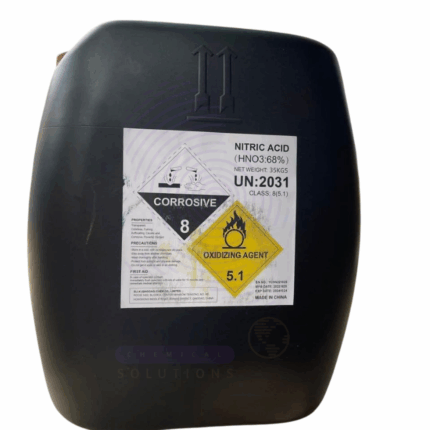


Diethyl Ether Extra Pure
$ 46.25 Original price was: $ 46.25.$ 45.12Current price is: $ 45.12.
Diethyl Ether Extra Pure is a volatile, highly flammable solvent widely used in laboratory settings for extractions, recrystallization, and as a reaction medium in organic synthesis. Its low boiling point and high volatility make it ideal for evaporative processes and rapid solvent removal. In analytical labs, it is commonly employed for liquid-liquid extraction due to its excellent miscibility with a variety of organic compounds. This extra pure grade ensures minimal impurities, making it suitable for sensitive chemical reactions and research applications. Proper storage in a tightly sealed, cool, and well-ventilated area is essential to maintain stability and safety.
Diethyl Ether Extra Pure
Primary Uses
- Solvent in Organic Reactions
- Widely used as a non-polar solvent for Grignard reactions, extractions, and recrystallizations.
- Reagent Preparation & Purification
- Common for dissolving fats, oils, waxes, and alkaloids during sample purification and separation techniques.
- Anaesthetic Research
- Historically important in anesthesia studies, still referenced in pharmacological lab simulations (non-clinical use only).
Secondary Uses
- Chromatography – Employed in TLC or column chromatography as an eluent or co-solvent.
- Microbiology – Occasionally used for lipid extraction from microbial biomass.
- Demonstration Labs – Its high volatility and flammability are useful for combustion experiments and evaporation studies.
| PACK SIZE |
2.5 Litres Glass bottle |
|---|
1. Basic Identification Attributes
- Chemical Name: Diethyl Ether
- Other Names: Ethyl ether, Ether
- Chemical Formula: C₄H₁₀O
- CAS Number: 60-29-7
- Grade: Extra Pure (Laboratory Grade)
- Molecular Weight: 74.12 g/mol
- Appearance: Clear, colorless volatile liquid
- Odor: Sweet, characteristic ether-like
2. Physical & Chemical Properties
- Boiling Point: 34.6 °C
- Melting Point: -116.3 °C
- Density: 0.713 g/cm³ at 20 °C
- Solubility: Slightly soluble in water; miscible with alcohol, chloroform, and many organic solvents
- Vapor Pressure: ~440 mmHg at 20 °C
- Flash Point: -45 °C (closed cup)
- Autoignition Temperature: ~160 °C
- Flammability: Extremely flammable
3. Safety & Hazard Attributes
- GHS Classification:
- Flammable Liquids (Category 1)
- Narcotic Effects (Category 3)
- Peroxide Former (Dangerous on prolonged exposure to air)
- Hazard Statements:
- H224: Extremely flammable liquid and vapor
- H336: May cause drowsiness or dizziness
- EUH019: May form explosive peroxides
- PPE Requirements:
- Flame-resistant lab coat
- Nitrile gloves
- Chemical splash goggles
- Use only in fume hood
- First Aid:
- Inhalation: Move to fresh air, administer oxygen if needed
- Skin Contact: Wash thoroughly with soap and water
- Eye Contact: Rinse immediately with plenty of water
- Ingestion: Do NOT induce vomiting; seek immediate medical attention
4. Storage & Handling Attributes
- Storage Conditions:
- Store in tightly sealed containers under inert gas (nitrogen/argon)
- Keep in a cool, dry, well-ventilated, flame-proof storage area
- Protect from light and air (to avoid peroxide formation)
- Stability Note:
- Diethyl ether forms explosive peroxides on standing—test regularly
- Store with added stabilizers unless specifically unstabilized
5. Regulatory & Compliance Attributes
- EC Number: 200-467-2
- UN Number: UN 1155
- Hazard Class (Transport): Class 3 (Flammable Liquids)
- Packing Group: I (high danger)
- REACH Registration: Registered
- DOT Classification (US): Flammable liquid
6. Laboratory Applications
- Primary Uses:
- Widely used as an organic solvent in labs
- Extraction of organics from aqueous solutions
- Grignard and other anhydrous reactions
- Recrystallization and purification processes
- Other Uses:
- Historical use as an anesthetic (no longer recommended)
- Cooling baths with dry ice
- Precursor or diluent in reagent preparation
SECURITY PRECAUTIONS
- PPE Required:
- Flame-resistant lab coat
- Nitrile or neoprene gloves
- Chemical splash goggles
- Work in a fume hood only
- Storage Guidelines:
- Store in tightly sealed containers under inert atmosphere (e.g., nitrogen)
- Keep in flammable solvent cabinets, away from heat, sparks, or open flames
- Protect from light to avoid peroxide formation
- Avoid long-term storage: test for peroxides periodically
- Handling Tips:
- Ground and bond containers when dispensing
- Never heat in open containers
- Avoid contact with strong oxidizers and acids
FIRST AID MEASURES
- Inhalation: Move to fresh air immediately; provide oxygen if needed
- Skin Contact: Wash with soap and water
- Eye Contact: Rinse thoroughly for 15 minutes and seek medical help
- Ingestion: Do not induce vomiting; get emergency medical assistance
FIRE SAFETY MEASURES
- Fire Hazard: Extremely flammable – forms explosive vapors
- Explosion Risk: Vapor can travel far to an ignition source
- Extinguishing Agents: Dry chemical, foam, or CO₂ (never use water directly)
- Combustion Products: CO, CO₂, potentially irritating vapors
Related products
Acetone Extra Pure
Aluminium Ammonium Sulphate Extra Pure
Aluminium Oxide Extra Pure
Aluminium Potassium Sulphate Hydrated Extra Pure
Ammonium Carbonate Extra Pure
Ammonium Carbonate Extra Pure is a high-quality, white crystalline solid widely used across various scientific, industrial, and food-related applications. Manufactured to stringent purity standards, this compound is ideal for laboratories and processes that demand high-grade reagents. With its characteristic ammonia-like odor and ability to decompose upon heating, ammonium carbonate plays a versatile role in both chemical reactions and physical processes.
In aqueous solution, ammonium carbonate breaks down into ammonium bicarbonate and ammonium carbamate, further releasing ammonia (NH₃) and carbon dioxide (CO₂) upon heating. This property makes it especially useful in applications that require controlled gas release or temporary pH modification.


 Preservatives(food)
Preservatives(food) Flavor Enhancers
Flavor Enhancers Acidulants
Acidulants Sweeteners
Sweeteners Antioxidants
Antioxidants Colorants(food)
Colorants(food) Nutraceutical Ingredients (food)
Nutraceutical Ingredients (food) Nutrient Supplements
Nutrient Supplements Emulsifiers
Emulsifiers
 Collectors
Collectors Dust Suppressants
Dust Suppressants Explosives and Blasting Agents
Explosives and Blasting Agents Flocculants and Coagulants
Flocculants and Coagulants Frothers
Frothers Leaching Agents
Leaching Agents pH Modifiers
pH Modifiers Precious Metal Extraction Agents
Precious Metal Extraction Agents
 Antioxidants(plastic)
Antioxidants(plastic) Colorants (Pigments, Dyes)
Colorants (Pigments, Dyes) Fillers and Reinforcements
Fillers and Reinforcements Flame Retardants
Flame Retardants Monomers
Monomers Plasticizers
Plasticizers Polymerization Initiators
Polymerization Initiators Stabilizers (UV, Heat)
Stabilizers (UV, Heat)
 Antifoaming Agents
Antifoaming Agents Chelating Agents
Chelating Agents Coagulants and Flocculants
Coagulants and Flocculants Corrosion Inhibitors
Corrosion Inhibitors Disinfectants and Biocides
Disinfectants and Biocides Oxidizing Agents
Oxidizing Agents pH Adjusters
pH Adjusters Scale Inhibitors( water)
Scale Inhibitors( water)
 Antioxidants(cosmetic)
Antioxidants(cosmetic) Emollients
Emollients Fragrances and Essential Oils
Fragrances and Essential Oils Humectants
Humectants Preservatives
Preservatives Surfactants(cosmetic)
Surfactants(cosmetic) Thickeners
Thickeners UV Filters
UV Filters
 Fertilizers
Fertilizers Soil Conditioners
Soil Conditioners Plant Growth Regulators
Plant Growth Regulators Animal Feed Additives
Animal Feed Additives Biostimulants
Biostimulants Pesticides (Herbicides, Insecticides, Fungicides)
Pesticides (Herbicides, Insecticides, Fungicides)
 Active Pharmaceutical Ingredients (APIs)
Active Pharmaceutical Ingredients (APIs) Excipients
Excipients Solvents(pharmaceutical)
Solvents(pharmaceutical) Antibiotics
Antibiotics Antiseptics and Disinfectants
Antiseptics and Disinfectants Vaccine Adjuvants
Vaccine Adjuvants Nutraceutical Ingredients (pharmaceutical)
Nutraceutical Ingredients (pharmaceutical) Analgesics & Antipyretics
Analgesics & Antipyretics
 Analytical Reagents
Analytical Reagents Solvents(lab)
Solvents(lab) Chromatography Chemicals
Chromatography Chemicals Spectroscopy Reagents
Spectroscopy Reagents microbiology-and-cell-culture-reagents
microbiology-and-cell-culture-reagents Molecular Biology Reagents
Molecular Biology Reagents Biochemical Reagents
Biochemical Reagents Inorganic and Organic Standards
Inorganic and Organic Standards Laboratory Safety Chemicals
Laboratory Safety Chemicals Specialty Laboratory Chemicals(Special Laboratory Equipment)
Specialty Laboratory Chemicals(Special Laboratory Equipment)
 Demulsifiers
Demulsifiers Hydraulic Fracturing Fluids
Hydraulic Fracturing Fluids Scale Inhibitors(oil)
Scale Inhibitors(oil) Surfactants(oil)
Surfactants(oil) Drilling Fluids
Drilling Fluids
 Dyes and Pigments
Dyes and Pigments Bleaching Agents
Bleaching Agents Softening Agents
Softening Agents Finishing Agents
Finishing Agents Antistatic Agents
Antistatic Agents
 Admixtures
Admixtures Waterproofing Agents
Waterproofing Agents Sealants and Adhesives
Sealants and Adhesives Curing Compounds
Curing Compounds Concrete Repair Chemicals
Concrete Repair Chemicals Anti-Corrosion Coatings
Anti-Corrosion Coatings
 Surfactants(cleaning)
Surfactants(cleaning) Builders
Builders Enzymes
Enzymes Solvents (Cleaning)
Solvents (Cleaning) Fragrances
Fragrances
 Electronic Chemicals
Electronic Chemicals Catalysts
Catalysts Lubricants
Lubricants Photographic Chemicals
Photographic Chemicals Refrigerants
Refrigerants Automotive chemicals
Automotive chemicals Pyrotechnic Chemicals
Pyrotechnic Chemicals
 Biodegradable Surfactants
Biodegradable Surfactants Bio-based Solvents
Bio-based Solvents Renewable Polymers
Renewable Polymers Carbon Capture Chemicals
Carbon Capture Chemicals Wastewater Treatment Chemicals
Wastewater Treatment Chemicals
 Pigments
Pigments Solvents(paint)
Solvents(paint) Specialty Coatings
Specialty Coatings Binders/Resins
Binders/Resins Additives
Additives Driers
Driers Anti-Corrosion Agents
Anti-Corrosion Agents Functional Coatings
Functional Coatings Application-Specific Coatings
Application-Specific Coatings
 Fresh Herbs
Fresh Herbs Ground Spices
Ground Spices Whole Spices
Whole Spices Spice Blends
Spice Blends Dried Herbs
Dried Herbs
 Leavening Agents
Leavening Agents Dough Conditioners
Dough Conditioners Flour Treatments
Flour Treatments Fat Replacers
Fat Replacers Decoratives
Decoratives Preservatives(baking)
Preservatives(baking)
 Plasticizers & Softeners
Plasticizers & Softeners Reinforcing Agents
Reinforcing Agents Adhesion Promoters
Adhesion Promoters Vulcanizing Agents
Vulcanizing Agents Antidegradants
Antidegradants Blowing Agents
Blowing Agents Fillers & Extenders
Fillers & Extenders Accelerators & Retarders
Accelerators & Retarders